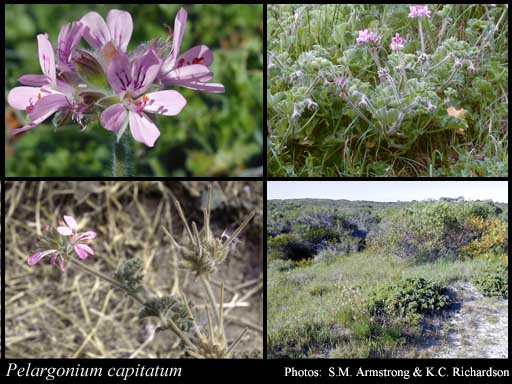- Reference
- Hort.Kew. [W. Aiton] 2:425 (1789)
- Conservation Code
- Not threatened
- Naturalised Status
- Alien to Western Australia
- Name Status
- Current
Straggling, shrubby perennial, herb, 0.1-1 m high. Fl. pink-purple/white, Feb to Apr or Aug to Dec. Sand. Coastal sand dunes & limestone.

Distribution
- IBRA Regions
- Esperance Plains, Geraldton Sandplains, Jarrah Forest, Swan Coastal Plain, Warren.
- IBRA Subregions
- Lesueur Sandplain, Perth, Recherche, Southern Jarrah Forest, Warren.
- IMCRA Regions
- Central West Coast, Leeuwin-Naturaliste, WA South Coast.
- Local Government Areas (LGAs)
- Albany, Armadale, Augusta Margaret River, Bunbury, Busselton, Cambridge, Capel, Cockburn, Cottesloe, Dandaragan, Denmark, Esperance, Gingin, Joondalup, Mandurah, Manjimup, Melville, Murray, Nedlands, Perth, Ravensthorpe, Rockingham, Serpentine-Jarrahdale, South Perth, Swan, Wanneroo, Waroona.
Management Notes (for the Swan NRM Region)
Alternative Names. Rose-scented Pelargonium, Rose Geranium.
General Biology. Growth form. Herb. Life form. Perennial. Reproduction. Seed, root fragments. Dispersal. Wind, water, soil. Seedbank persistence. Medium to long term, 2+ years. Fire response. Frequent and/or intense fires create conditions suitable for greater invasion..
Notes. Is a major weed of Banksia woodland and coastal heathland. Invasion in Banksia woodland can be facilitated by disturbance including frequent fire. Frequent and/or intense fires create conditions suitable for greater invasion, including increased soil phosphorous levels. Seed is elliptically shaped, with a feathered, tail-like coiled spiral structure attached. This tail allows the seed to drill and secure itself in soil if twisted by the wind or affected by movement of animals. Seed has high levels of physical dormancy, which can be broken by high and/or low winter temperatures..
Additional information. Origin. South Africa. History of use/introduction. Ornamental, gene source (ornamental features), medicinal. Similar exotic species. Geranium molle, Pelargonium x asperum. Similar native species. P. littorale.
Suggested method of management and control. Hand pull isolated plants taking care to remove the entire stem as it can reshoot from below ground level. Spot spray metsulfuron methyl 5 g/ha + Pulse®. Easily controlled after fire. Read the manufacturers' labels and material safety data sheets before using herbicides. For further information consult the Australian Pesticides and Veterinary Medicines Authority to determine the status of permits for your situation or state.
Management Calendar
| Calendar Type | Jan | Feb | Mar | Apr | May | Jun | Jul | Aug | Sep | Oct | Nov | Dec | Comments |
|---|---|---|---|---|---|---|---|---|---|---|---|---|---|
| Active Growth | O | Y | Y | Y | Y | Y | Y | O | |||||
| Germination | O | Y | Y | Y | Y | ||||||||
| Flowering | Y | Y | Y | Y | Y | ||||||||
| Fruiting | Y | Y | Y | ||||||||||
| Manual Removal | O | O | O | O | O | Y | Y | Y | Y | Y | Y | O | |
| Herbicide Treatment | Y | Y | Y | Y | Y |
Legend: Y = Yes, regularly, O = Occasionally, U = Uncertain, referred by others but not confirmed.
References
- Adams, T. (2005) Pelargonium capitatum (L.) L'Hér. South Africa National Biodiversity Institute URL: http://www.plantzafrica.com/ - Accessed March 2010.
- Brown, K. & Brooks, K. (2002) Bushland Weeds: A Practical Guide to their Management. Environmental Weeds Action Network, Greenwood.
- Fisher, J.L., Veneklaas, E.J., Lambers, H. & Loneragan, W.A. (2006) Enhanced soil and leaf nutrient status of a Western Australian Banksia woodland community invaded by Ehrharta calycina and Pelargonium capitatum. Plant and Soil, 284 (1-2): 253-264.
- Hussey, B.M.J., Keighery, G.J., Dodd, J., Lloyd, S.G. & Cousens, R.D. (2007) Western Weeds. A guide to the weeds of Western Australia. 2nd Edition. The Plant Protection Society of Western Australia, Victoria Park.
- Meisert, A. (2002) Physical dormancy in Geraniaceae seeds. Seed Science Research, 12: 121-128.
- Plants For a Future (Undated) Pelargonium capitatum - (L.)L'Hér, Rose-Scented Geranium. URL: http://www.pfaf.org/ - Accessed March 2010.
- Swarbrick, J.T. & Skarratt, D.B. (1994) The bushweed 2 database of environmental weeds in Australia. The University of Queensland, Gatton College.
- USDA, ARS, National Genetic Resources Program (2009) Germplasm Resources Information Network - (GRIN). National Germplasm Resources Laboratory, Beltsville, Maryland. URL: https://npgsweb.ars-grin.gov/gringlobal/taxon/taxonomysimple.aspx - Accessed October 2009.